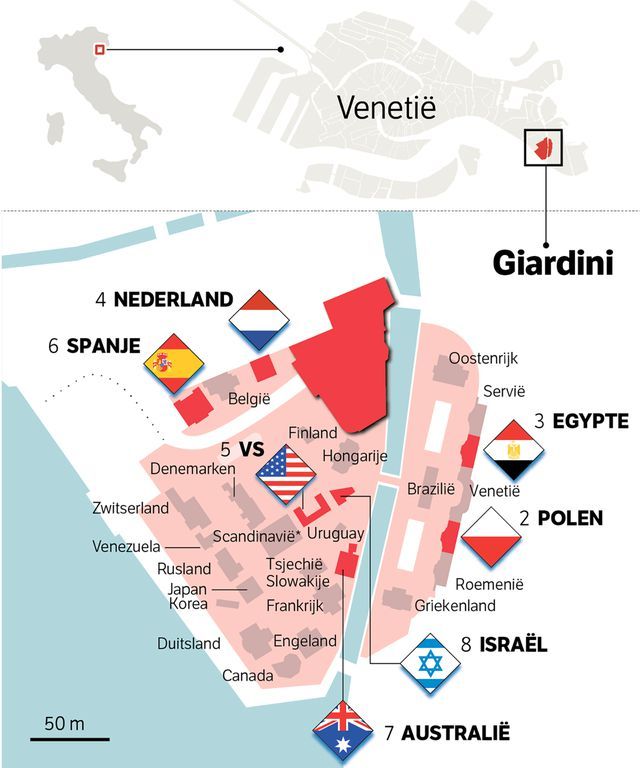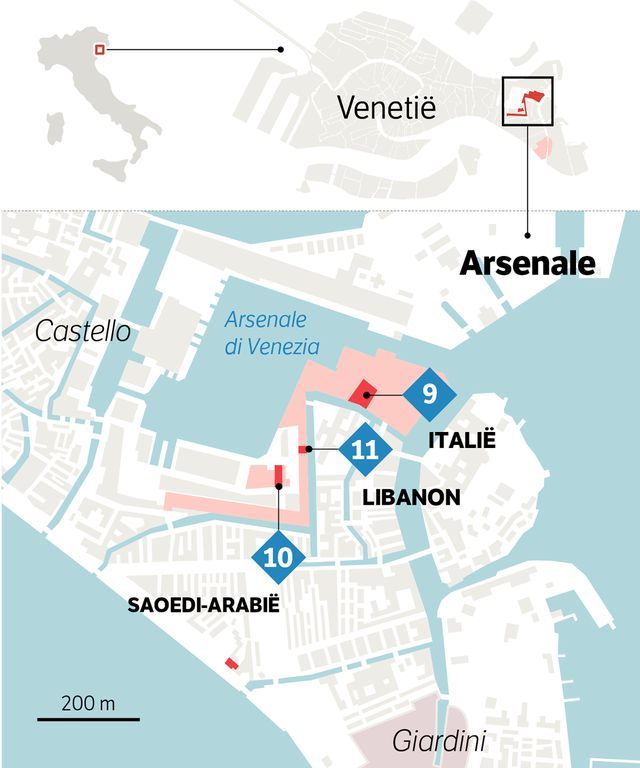With more than 80 country pavilions, a large main exhibition and numerous exhibitions throughout the city, the Venice Biennale is one of the most important art events worldwide every two years. Main locations are the Giardini, a park area with country pavilions in the historic city and Arsenale, a centuries-old naval complex. What are the themes this year and which exhibitions and pavilions stand out? A tour of eighteen highlights:
In the Giardini and Arsenale:
1. Main exhibitionForeigners Everywhere – Stranieri Ovunque
With this message, Brazilian curator Adriano Pedrosa curated the main exhibition of the Biennale. More attention is paid to art from the Global South and more attention is paid to the cultural traditions from that part of the world. So brings Foreigners Everywhere a multitude of global visual languages, perspectives and visions together that make an impression.
Also read
The Venice Biennale is once again making important progress: more art from the South
Also read
“Art will not save us from bombs,” said Olena Zelenska at the opening of the Venice Biennale. What?
In the Giardini:

2. PolandRepeat after me
Have fled from Kharkiv, Mariupol, Kyiv, among others, to end up in various places in Europe. The art collective Open Group asked some Ukrainian refugees to imitate the sound of weapons. Large and small rockets, anti-aircraft guns, machine guns: they all have their own sound. After the sound has been performed a few times, the spectator is invited to participate. For those who are still unmoved by the sounds and stories: the microphones for a karaoke session are ready.
3. EgyptDrama 1882
Alexandria-born Wael Shawky has a fascination with dolls, and this is reflected in his great film Drama 1882. It tells how a rebellion between 1879 and 1882, led by the Egyptian independence fighter Ahmed Urabi, was crushed. With intelligent humor, nods to silent films and sweet songs and dance in a deliberately clichéd setting, Shawky gives a fascinating history lesson.
4. NetherlandsThe International Celebration of Blasphemy and the Sacred
The cocoa sculptures of the Congolese artist collective CATPC spread a sweet scent through the Dutch pavilion at the Venice Biennale. Together they tell a compelling, coherent story about decolonization
5. United StatesThe-space-in-which-to-place-me
While Nina Simone sings ‘We Want To Be Free’, as a spectator you walk past the beaded busts and animals, past videos in which a dance becomes increasingly abstract, as if you are looking through a children’s kaleidoscope and different figures emerge as they spin. Jeffrey Gibson is the first indigenous artist to represent America at the Venice Biennale. The result is fantastic.
6. SpainPinacoteca Migrante
In the Spanish pavilion, Peruvian artist Sandra Gamarra shows how not only the Spanish shaped her country, but also how landscape paintings from the time of the beginning of colonization presented the country as desolate and empty. That gave the Spaniards a license to run rampant there, but how empty was that country really? Gamarra shows new worlds from the past and brilliantly links them to contemporary issues.
7. AustraliaKith and Kin
A huge family tree is drawn in chalk on the walls and ceiling. Thanks to its many branches, artist Archie Moore was able to go back 65,000 years in time. The impressive pavilion received the Golden Lion this year. The jury rightly noted: “This installation stands out for its strong aesthetics, its lyricism and its display of shared loss of a hidden past. With his inventory of thousands of names, Moore also offers a glimmer of opportunity for recovery.”
8. Israel
Israeli artist Ruth Patir turned her entry into a statement and conceptual artwork rolled into one when she posted this note on the windows of the pavilion: “The artist and curators of the Israeli pavilion will open the exhibition once there is a ceasefire and an agreement has been reached about releasing the hostages.”
In Arsenale:

9. ItalyDue Qui/To Hear
The largest pavilion is that of Italy, which is located at the very edge of the Arsenale. It is one of the few pavilions in which the stories of politics, colonialism and identity are absent and yet fits perfectly into the whole. This is thanks to the chosen medium: sound. At the front is a huge organ pipe, which produces a low tone that you feel more than you hear. Ethereal choir singing can be heard in the garden, and in between Massimo Bartolini has erected a gigantic maze of scaffolding poles, containing normal-sized organ tubes. They are controlled by a kind of giant music box that plays a composition by Gavin Bryars. The whole does not tolerate contradiction, but in a different way than most pavilions.
10. Saudi ArabiaShifting Sands: A Battle Song
The role of women is central to the work that Manal Aldowayan made for the Saudi pavilion. You walk through a kind of mountain landscape, in which texts in Arabic and English alternate with drawings. In the meantime you will hear the music that Aldowayan composed for this installation. The whole thing is an impressive call for change, with an eye for solidarity between women worldwide, which is now also reaching Saudi Arabia.
11. LebanonA Dance with her Myth
Artist Mounira Al Solh recreates the Greek myth of the kidnapping of Europe in her installation. In 41 works she reshuffles the story of the Greeks into a witty myth in cheerful colors. As if you are walking through a set, the works are decorated with ‘remnants’ from that time. The story of Europe is not only timeless, but also requires reflection on the role of women, their ambitions and struggles.
In the city:

12. TaiwanEvery Day War
Taiwan, which is officially a ‘collateral event’ rather than a country pavilion, is present with Everyday war, a solo exhibition by Yuan Goang-Ming that largely consists of video art. With images of a cozy room where books suddenly explode in the cupboard, or images of an empty road where protests against China have been suppressed. The most impressive is ‘Prophecy’, a neatly set table that vibrates to the sounds of falling bombs.
13. NigeriaNigeria Imaginary
Nine artists living in diaspora look at how they see the future for their country, and back to the (colonial) past. The imagination reigns supreme: photographs, paintings, drawings, replicas of looted art together form the Mbari Club, a club founded in the 1960s by writers, artists and intellectuals to express their vision of the new Nigeria – which was independent in 1960. has become – to express and imagine.
14. William KentridgeSelf-portrait as a Coffeepot
A video work in nine parts that will keep you busy for four hours. Highly recommended to see how the South African artist creates worlds with his charcoal, collages and music, while chatting with his alter ego about the meaning of his work only to undermine it with self-mockery.
15. Jean CocteauThe Juggler’s Revenge
The versatility of Jean Cocteau is clearly highlighted here: from graphic work to films, ballet to the often witty homoerotica, from the rich social life to commercial exploitation.
16. Berlinde De Bruyckere: City of Refuge III
An impressive exhibition by Berlinde De Bruyckere can be seen in the church and abbey of San Giorgio Maggiore. Largely made specifically for the space, with enormous canvases and mirrors, partly with material that has been damaged by nature, it is the third exhibition named after the song ‘City of Refuge’ by Nick Cave, a pitch-dark song about sin (‘The blood won’t come off, you better run’). Simply existing is hard work.
17.ThailandThe Spirits of Maritime Crossing
A little masked girl takes Marina Abramovic, who plays a role in this Thai film, through the streets and rivers of Bangkok where she has several encounters with people who are facing a phase of life. Abramovic walks extremely slowly, and yet the film is fascinating. The highlight of this pavilion is a Stations of the Cross with lights and small pieces of Lego stuck to the images.
18. Gallerie dell’AccademiaWillem de Kooning e l’Italia
Willem de Kooning has only been to Italy twice, but those trips have made an impression, is the thesis of this exhibition. Works on view from the late 1950s to the 1980s are initially bursting with energy (jumpy drawings, colorful paintings, rugged sculptures) and eventually become increasingly tranquil, when De Kooning wipes away colors, sometimes leaving a simple and penetrating interplay of lines.
Eighteen highlights on the map:
To share
Email the editor










